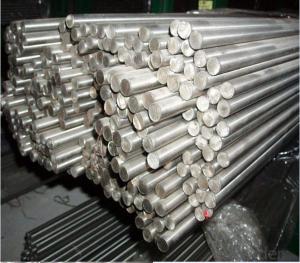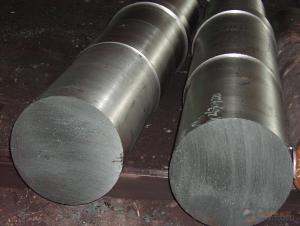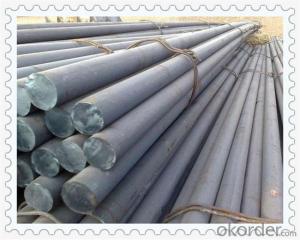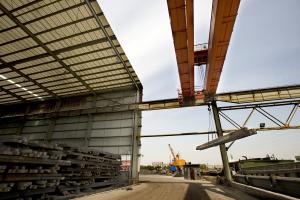cold drawn steel round bar to Aisa market
- Loading Port:
- Tianjin
- Payment Terms:
- TT or LC
- Min Order Qty:
- 5000 m.t.
- Supply Capability:
- 35000 m.t./month
OKorder Service Pledge
OKorder Financial Service
You Might Also Like
Specifications of Carbon Steel Round Bar
1. Grade: Q235, SS400, S235JR, A36
2. Sizes: Diameter: 6mm-150mm; Length: 6m, 9m, 12m or as customer’s request
3. Type: Mild steel; Low carbon steel
4. Shape: Round bar, solid bar of steel with circular section
5. Technique: Hot rolled or cold drawn
6. Mass: Mass(kg/m) = Diameter(mm)×Diameter(mm)×0.00617
Steel Type | Maximum forging temperature (°F / °C) | Burning temperature (°F / °C) |
1.5% carbon | 1920 / 1049 | 2080 / 1138 |
1.1% carbon | 1980 / 1082 | 2140 / 1171 |
0.9% carbon | 2050 / 1121 | 2230 / 1221 |
0.5% carbon | 2280 / 1249 | 2460 / 1349 |
0.2% carbon | 2410 / 1321 | 2680 / 1471 |
3.0% nickel steel | 2280 / 1249 | 2500 / 1371 |
3.0% nickel–chromium steel | 2280 / 1249 | 2500 / 1371 |
5.0% nickel (case-hardening) steel | 2320 / 1271 | 2640 / 1449 |
Usage and Applications of Carbon Steel Round Bar
Carbon steel round bar is the most common form of steel because its price is relatively low while it provides material properties that are acceptable for many applications, more so than iron. It is often used when large quantities of steel are needed, for example as structural steel. The density of this product is approximately 7.85g/cm³ and the young's modulus, like all steels.
Packaging & Delivery of Carbon Steel Round Bar
Packaging Detail: All goods are packed in bundle with steel strips and shipped by break bulk vessel or container (depend on target market and different ports)
Delivery Detail: 45 days
Trade terms: FOB, CFR, CIF
MOQ: 25 tons per specification; we can negotiate the quantity if the specification is normal or we have stock of one specification.
Weight: The price invoicing on theoretical weight basis or actual weight basis depends on customer’s request.
Shipment: The shipment of bulk break or container is depends on customer’s request and the situation of the port of destination.
Documents given: Full set of original clean on board bill of lading; Original signed commercial invoice; Original packing list; Policy of insurance; Certificate of origin and what the target market needs.
FAQ:
Q1: Why buy Materials & Equipment from OKorder.com?
A1: All products offered byOKorder.com are carefully selected from China's most reliable manufacturing enterprises. Through its ISO certifications, OKorder.com adheres to the highest standards and a commitment to supply chain safety and customer satisfaction.
Q2: How do we guarantee the quality of our products?
A2: We have established an advanced quality management system which conducts strict quality tests at every step, from raw materials to the final product. At the same time, we provide extensive follow-up service assurances as required.
Q3: How soon can we receive the product after purchase?
A3: Within three days of placing an order, we will begin production. The specific shipping date is dependent upon international and government factors, but is typically 7 to 10 workdays.


- Q: Can steel round bars be used in the production of sporting goods?
- Yes, steel round bars can be used in the production of sporting goods. Steel is a versatile material known for its strength and durability, making it suitable for various applications in the sporting goods industry. Steel round bars can be used to create components such as shafts, handles, frames, and supports in sporting equipment like golf clubs, hockey sticks, weightlifting bars, and exercise equipment. The high tensile strength of steel ensures that these components can withstand the forces and pressures exerted during sports activities, providing stability and longevity to the products. Moreover, steel round bars can be easily machined, welded, and molded into different shapes and sizes according to the specific requirements of each sporting good. Steel's corrosion resistance properties also make it ideal for outdoor sporting equipment that is exposed to various weather conditions. Overall, steel round bars are a popular choice in the production of sporting goods due to their strength, durability, versatility, and ability to withstand the demands of different sports.
- Q: What are the advantages of using tool steel round bars?
- Tool steel round bars offer numerous benefits. Firstly, they boast outstanding hardness and wear resistance, making them perfect for high-stress applications like manufacturing cutting tools, dies, and molds. The hardness of tool steel also enables precise machining, resulting in accurate and intricate shapes. Secondly, tool steel round bars possess exceptional toughness and impact resistance, enabling them to withstand heavy-duty applications without breaking or cracking. This makes them suitable for demanding industries such as aerospace, automotive, and construction. Moreover, tool steel round bars are renowned for their high temperature resistance, maintaining their hardness and strength even in extreme heat. This is particularly advantageous in applications exposed to high temperatures, like forging or heat treating operations. Another advantage is the dimensional stability of tool steel round bars. They have a low coefficient of thermal expansion, meaning they undergo minimal dimensional changes when subjected to temperature variations. This ensures reliability and predictability in various operating conditions. Furthermore, tool steel round bars can be easily machined and heat treated to achieve specific properties. This versatility allows manufacturers to tailor the material to their specific needs, enhancing the overall performance of the end product. Additionally, tool steel round bars are readily available and cost-effective. They are widely produced and stocked by suppliers, ensuring easy accessibility for various applications. Furthermore, their longevity and resistance to wear and tear contribute to their cost-effectiveness. In conclusion, the advantages of using tool steel round bars include exceptional hardness, toughness, high temperature resistance, dimensional stability, versatility, availability, and cost-effectiveness. These properties make them the preferred choice in industries where durability, precision, and reliability are paramount.
- Q: Are steel round bars suitable for outdoor sculptures?
- Yes, steel round bars are suitable for outdoor sculptures due to their durability, weather resistance, and versatility in shaping various forms and designs.
- Q: Can steel round bars be used in the manufacturing of springs?
- Indeed, the utilization of steel round bars in the production of springs is possible. Steel, being a prevalent material in spring manufacturing, is favored for its remarkable attributes including remarkable strength, endurance, and flexibility. By employing diverse manufacturing techniques like hot rolling, cold drawing, or machining, steel round bars can be skillfully transformed and molded into the desired spring shape. The selection of the precise type of steel round bar relies on the application and specific characteristics sought after for the spring, such as the desired level of rigidity or resilience. All in all, steel round bars are extensively employed and deemed as a dependable option for spring production.
- Q: How do you calculate the deflection of a steel round bar?
- To calculate the deflection of a steel round bar, you need to consider various factors such as the bar's length, diameter, and the applied load. The deflection of a bar refers to the amount it bends or flexes under a specific load. The deflection can be determined using the formula for beam deflection, which is derived from Euler-Bernoulli beam theory. The formula is as follows: δ = (F * L^3) / (48 * E * I) Where: - δ represents deflection - F is the applied load - L is the length of the bar - E is the modulus of elasticity of the steel material - I is the moment of inertia of the round bar To calculate the moment of inertia (I) for a round bar, you can use the formula: I = (π * D^4) / 64 Where: - I is the moment of inertia - D is the diameter of the round bar By substituting the values into the formula, you can calculate the deflection of the steel round bar under the given load. It is important to note that these calculations assume the bar is perfectly elastic and obeys the principles of linear elasticity.
- Q: Can steel round bars be used for making springs?
- Yes, steel round bars can be used for making springs. Steel is a widely used material for springs due to its high strength and durability. Steel round bars can be shaped into various types of springs, including compression springs, extension springs, and torsion springs. The round bar can be cut to the desired length and then heat-treated to achieve the desired hardness and springiness. The specific type of steel and the heat treatment process will determine the spring's characteristics, such as its load-bearing capacity, flexibility, and resistance to fatigue. However, it is important to note that the design and engineering of springs require careful consideration of factors such as the required spring rate, maximum load, and operating conditions to ensure the optimal performance of the spring.
- Q: What are the different types of steel round bar heat treatments?
- There are several different types of heat treatments for steel round bars, each designed to enhance specific properties of the material. Some of the most common heat treatments include annealing, normalizing, quenching and tempering, and case hardening. 1. Annealing: This heat treatment involves heating the steel round bar to a high temperature and then slowly cooling it to room temperature. Annealing helps to relieve internal stresses, improve machinability, and increase ductility and toughness. 2. Normalizing: Similar to annealing, normalizing also involves heating the steel round bar to a specific temperature. However, instead of slow cooling, the bar is allowed to cool in air. Normalizing helps to refine the grain structure, enhance mechanical properties, and improve machinability. 3. Quenching and Tempering: Quenching is a process in which the steel round bar is heated to a high temperature and then rapidly cooled by immersing it in a quenching medium, such as oil or water. This rapid cooling helps to achieve high hardness and strength in the material. After quenching, the steel is often tempered by reheating it to a lower temperature, which improves toughness and reduces brittleness. 4. Case Hardening: This heat treatment is used to increase the surface hardness of the steel round bar while maintaining a tough core. Case hardening involves heating the bar in the presence of carbon-rich substances, such as gas or liquid carburizing agents. This results in a hardened outer layer, known as the case, while the core remains relatively softer and more ductile. These are just a few examples of the various heat treatments that can be applied to steel round bars. The specific heat treatment used depends on the desired properties and applications of the steel, and it is important to consult with metallurgical experts to ensure the most appropriate treatment is chosen for each specific steel round bar.
- Q: What is the elongation of a steel round bar?
- The elongation of a steel round bar refers to the amount of lengthening or stretching the bar undergoes when subjected to an applied force or load.
- Q: What are the advantages of using sulfur-alloy steel round bars?
- There are several advantages of using sulfur-alloy steel round bars. Firstly, sulfur-alloy steel round bars offer improved machinability, making it easier to shape and cut the material into desired forms. Additionally, the sulfur content in the alloy enhances the overall strength and hardness of the steel, making it more durable and resistant to wear and tear. Moreover, sulfur-alloy steel round bars have excellent thermal conductivity, allowing for efficient heat transfer during various applications. Lastly, these bars are cost-effective as they offer a combination of desirable properties at a relatively lower price compared to other specialized alloys.
- Q: What are the advantages of using copper-alloy steel round bars?
- There are several advantages of using copper-alloy steel round bars in various applications. Firstly, copper-alloy steel round bars offer excellent corrosion resistance. The presence of copper in the alloy helps to protect the steel from rust and corrosion, making it suitable for use in environments with high levels of moisture or chemicals. This corrosion resistance extends the lifespan of the round bars, reducing the need for frequent replacements and maintenance. Secondly, copper-alloy steel round bars have high thermal and electrical conductivity. The copper content in the alloy enhances these properties, making them ideal for applications that require efficient heat transfer or electrical conductivity. This makes them suitable for use in electrical components, heat exchangers, and other similar applications. Another advantage of copper-alloy steel round bars is their superior machinability. Copper has excellent machinability properties, which allows for easy cutting, drilling, and shaping of the round bars. This makes them easier to work with and reduces machining time and costs. Additionally, copper-alloy steel round bars offer good strength and toughness. The steel component in the alloy provides the necessary strength to withstand heavy loads and impacts, while the copper component enhances the toughness, making them resistant to cracking or breaking under stress. This makes them suitable for use in structural applications, where high strength and durability are required. Furthermore, copper-alloy steel round bars exhibit good thermal stability. They can withstand high temperatures without losing their mechanical properties, making them suitable for applications that involve exposure to extreme heat or thermal cycling. In conclusion, the advantages of using copper-alloy steel round bars include excellent corrosion resistance, high thermal and electrical conductivity, superior machinability, good strength and toughness, and high thermal stability. These properties make them a preferred choice in various industries, including construction, electrical, automotive, and manufacturing.
Send your message to us
cold drawn steel round bar to Aisa market
- Loading Port:
- Tianjin
- Payment Terms:
- TT or LC
- Min Order Qty:
- 5000 m.t.
- Supply Capability:
- 35000 m.t./month
OKorder Service Pledge
OKorder Financial Service
Similar products
Hot products
Hot Searches
Related keywords



























